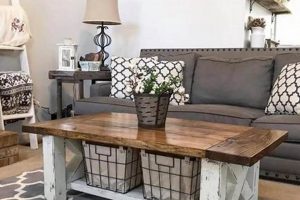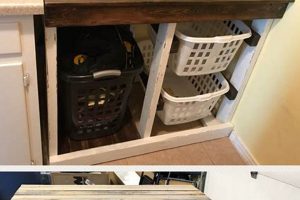A self-assembled, thick, wooden surface, often composed of fused wooden staves, intended for food preparation, can be repurposed and adapted for use as a surface for dining. This repurposing involves acquiring a suitable wooden panel, often pre-fabricated, and constructing a supporting base to achieve the desired height and stability. The resulting furniture piece provides a robust and aesthetically appealing alternative to conventional dining surfaces.
The appeal of this type of furniture construction lies in its potential for customization and cost-effectiveness. Its creation allows for precise tailoring of dimensions and design to specific spatial constraints and aesthetic preferences. Historically, butcher block surfaces were valued for their durability in professional kitchens; their adoption in residential settings reflects a desire for similar longevity and a natural, organic design element. The resultant piece provides a tangible connection to craftsmanship and sustainability.
The subsequent sections will elaborate on the key considerations in creating such a furniture piece, encompassing material selection, the assembly process, appropriate finishing techniques to ensure longevity and food safety, and the design options available for creating a unique and personalized piece of furniture.
Essential Considerations for Butcher Block Dining Table Construction
Successfully building a durable and aesthetically pleasing dining surface from a thick wooden panel requires careful planning and execution. These guidelines offer essential considerations for ensuring project success.
Tip 1: Wood Species Selection: Prioritize hardwoods such as maple, walnut, or cherry due to their density and resistance to wear. Softwoods are generally unsuitable due to their susceptibility to denting and scratching.
Tip 2: Moisture Content Management: Acclimate the wooden panel to the environment where it will be used to minimize warping or cracking. Employ a moisture meter to verify adequate equilibration. Aim for a moisture content appropriate for the regional climate.
Tip 3: Base Stability and Support: Design a base that provides adequate support for the weight of the surface. Metal or sturdy wood frames are recommended. Ensure secure attachment of the surface to the base using appropriate hardware and joinery techniques.
Tip 4: Surface Preparation: Thoroughly sand the surface to achieve a smooth, even finish. Begin with coarser grits and progress to finer grits to remove imperfections and prepare the wood for finishing. Proper sanding is crucial for achieving a professional-looking result.
Tip 5: Food-Safe Finishing: Apply a food-safe finish, such as mineral oil, beeswax, or a specialized butcher block oil. Multiple coats are typically necessary. Allow ample drying time between coats. This protects the wood from moisture and bacteria, ensuring a sanitary surface for dining.
Tip 6: Edge Treatment and Profiling: Consider the edge profile of the surface. Options range from a simple square edge to rounded or beveled edges. Choose an edge profile that complements the overall design and enhances comfort.
Tip 7: Addressing Wood Movement: Incorporate design elements that accommodate natural wood movement. Avoid rigidly fixing the surface to the base; instead, use slotted screw holes or other techniques that allow for expansion and contraction without causing stress or cracking.
These guidelines offer a foundation for creating a lasting and functional dining surface. Meticulous attention to each detail contributes to the overall quality and longevity of the finished piece.
The concluding section will summarize the key aspects and provide additional resources for further exploration.
1. Material Selection
The selection of appropriate materials is fundamental to the structural integrity, longevity, and aesthetic quality of a self-assembled dining table utilizing a butcher block surface. The chosen wood species and adhesive impact the table’s ability to withstand daily use, resist moisture, and maintain a presentable appearance.
- Hardwood Density and Durability
Hardwood species such as maple, walnut, and cherry are preferred due to their high density. Greater density translates to increased resistance to dents, scratches, and general wear. Softwoods, such as pine, are unsuitable because they are prone to damage, rendering them less viable for a high-use surface like a dining table. This choice affects the long-term appearance and usability.
- Wood Grain and Aesthetic Considerations
The grain pattern inherent to different wood species significantly influences the final appearance. Walnut offers a rich, dark tone and complex grain patterns, while maple provides a lighter, more uniform appearance. Cherry develops a reddish hue over time. The selection should complement the design of the base and the surrounding interior.
- Moisture Content and Stability
The moisture content of the wood at the time of construction is crucial. Wood expands and contracts with changes in humidity. Using wood that is not properly acclimated to the intended environment can lead to warping, cracking, or joint failure. Kiln-dried lumber is generally recommended to minimize these risks. Stable material selection ensures long term structural integrity.
- Adhesive Properties and Safety
The adhesive used to join the individual staves of the butcher block, if pre-fabricated, or to secure the surface to the base must be durable and, ideally, food-safe. Polyurethane-based adhesives offer high strength and water resistance. Epoxy resins provide exceptional bond strength and gap-filling capabilities. Ensuring compatibility with the wood species and intended use is imperative.
Ultimately, the selection of materials directly determines the suitability of the finished piece. Factors such as hardwood choice, aesthetic preference, moisture content, adhesive qualities, and safety must be balanced to yield a self-assembled dining table that meets performance criteria and aesthetic demands, aligning functionality with personal style.
2. Base Construction
The base of a dining table constructed with a butcher block top is critical for stability, support, and overall aesthetic integration. Proper base design and execution are essential to ensure the table’s long-term usability and prevent structural failure under the significant weight of the wooden surface.
- Material Selection for the Base
The choice of materials for the base significantly influences the table’s stability and visual style. Metal bases, typically steel or iron, offer high strength and a modern aesthetic. Wood bases, constructed from hardwoods like oak or maple, provide a more traditional look but require careful joinery to ensure rigidity. The selected material should complement the butcher block top and withstand the stresses of everyday use.
- Structural Design and Load Distribution
The base’s structural design must effectively distribute the weight of the butcher block top. Common designs include four-legged configurations, pedestal bases, and trestle bases. Four-legged designs offer balanced support but can obstruct legroom. Pedestal bases provide more legroom but may be less stable for larger tops. Trestle bases distribute weight evenly but require robust construction to prevent swaying. Accurate load calculations are crucial to prevent failure.
- Joinery Techniques and Hardware
The joinery techniques used to assemble the base directly impact its strength and stability. Wood bases benefit from mortise-and-tenon joints, dovetail joints, or strong screw connections with appropriate wood glue. Metal bases often employ welding or bolted connections. The hardware used to attach the base to the butcher block top should be robust and designed to accommodate wood movement, preventing cracking or warping of the wood.
- Aesthetic Integration and Finish
The design of the base should complement the style of the butcher block top and the overall aesthetic of the dining space. Metal bases can be powder-coated or painted to match existing dcor. Wood bases can be stained, painted, or left natural. Attention to detail, such as smooth welds or clean joinery, enhances the visual appeal of the finished table. Proper finishing protects the base from moisture and wear, ensuring long-term durability.
In summary, careful consideration of material selection, structural design, joinery techniques, and aesthetic integration is essential for creating a stable and visually appealing base for a dining table constructed using a butcher block top. The base is not merely a support structure but an integral design element that contributes to the table’s overall functionality and aesthetic value.
3. Surface Preparation
Surface preparation is a critical stage in the construction of a dining table featuring a butcher block top. It directly influences the final finish, durability, and overall aesthetic of the piece. Neglecting proper surface preparation can result in an uneven finish, reduced resistance to moisture, and a diminished lifespan of the tabletop.
- Sanding Progression and Grit Selection
Sanding is essential for creating a smooth, uniform surface. This process involves progressing through a series of increasingly finer sandpaper grits, typically beginning with a coarse grit (e.g., 80-grit) to remove imperfections and ending with a fine grit (e.g., 220-grit or higher) to refine the surface. Proper grit selection ensures efficient material removal and prevents excessive scratching. Failure to follow this progression can leave visible scratches or an uneven texture, impacting the final appearance of the dining table.
- Addressing Imperfections and Repairs
Butcher block surfaces may contain imperfections such as knots, checks, or small voids. These imperfections must be addressed prior to finishing. Knot filling compounds or wood epoxy can be used to fill voids, creating a smooth, continuous surface. Addressing these imperfections ensures a more consistent and aesthetically pleasing finish, enhancing the overall quality of the dining table.
- Dust Removal and Contamination Prevention
Thorough dust removal is crucial between sanding stages and prior to applying any finish. Residual dust particles can contaminate the finish, resulting in an uneven texture or visible imperfections. Methods for dust removal include vacuuming, wiping with a tack cloth, or using compressed air. Maintaining a clean work environment prevents contamination and ensures a smooth, professional finish on the dining table.
- Flattening Techniques for Uneven Surfaces
Some butcher block surfaces may exhibit slight warping or cupping. Flattening techniques, such as using a hand plane or a belt sander with a flattening jig, may be necessary to create a truly level surface. Flattening ensures that the dining table is stable and that objects placed on the surface do not rock or wobble. A flat, level surface is essential for both functionality and aesthetic appeal.
These elements of surface preparation collectively contribute to the quality and longevity of a butcher block dining table. Proper sanding, addressing imperfections, meticulous dust removal, and, if necessary, flattening techniques ensure that the final finish is smooth, durable, and visually appealing, enhancing the overall value and usability of the finished piece.
4. Food-Safe Finish
The application of a food-safe finish is paramount when constructing a dining table with a butcher block surface. This consideration directly addresses the potential for direct contact between food and the wood, mitigating health risks associated with contamination and ensuring the durability of the wooden surface.
- Regulatory Compliance and Certification
A critical aspect of food-safe finishes involves adherence to regulatory standards set by organizations such as the FDA or NSF. These bodies provide certifications for finishes that have undergone testing and are deemed safe for contact with food. Compliance with these regulations ensures that the chosen finish does not leach harmful chemicals into food or harbor bacteria, safeguarding the health of individuals using the dining table. Examples of compliant finishes include certain mineral oils, beeswax blends, and specific polyurethane formulations designed for food contact. These certifications are an important consideration when selecting a finish for a DIY project.
- Material Composition and Chemical Inertness
The material composition of a food-safe finish determines its ability to resist degradation from food acids, oils, and moisture. Chemically inert finishes are crucial to prevent the absorption of liquids, which can lead to bacterial growth and surface staining. Examples include pure mineral oil, which provides a barrier against moisture penetration, and certain polymerized tung oils that form a durable, chemically resistant surface. The selection of a finish with appropriate chemical inertness is essential for maintaining the integrity and hygiene of the butcher block dining table.
- Application Techniques and Curing Process
The proper application of a food-safe finish is as critical as the finish itself. Following the manufacturer’s instructions for application techniques, such as the number of coats, drying times, and sanding between coats, ensures the finish achieves its intended properties. A proper curing process, which allows the finish to fully harden and become inert, is essential for preventing the release of volatile organic compounds (VOCs) and ensuring the finish’s long-term durability. Neglecting proper application and curing can compromise the finish’s food safety and overall effectiveness.
- Maintenance and Longevity
Maintaining a food-safe finish involves regular cleaning and reapplication to preserve its protective qualities. Frequent use can degrade the finish over time, requiring periodic reapplication to maintain its barrier against moisture and bacteria. Proper cleaning with mild, food-safe detergents is essential to prevent the buildup of contaminants. Regular maintenance extends the lifespan of the finish and ensures the continued safety and hygiene of the butcher block dining table.
The implementation of a food-safe finish on a self-assembled dining table is not merely an aesthetic choice but a crucial health and safety consideration. By selecting compliant materials, adhering to proper application techniques, and implementing a consistent maintenance regimen, the resulting furniture piece serves as a durable, hygienic, and safe surface for food consumption and preparation.
5. Edge Detailing
Edge detailing, as applied to a self-assembled dining table with a butcher block surface, significantly influences both the aesthetic appeal and the functional usability of the finished piece. Careful consideration of edge profiles is essential to ensure comfort, safety, and stylistic coherence.
- Profile Selection and Ergonomics
The profile of the tabletop edge affects the comfort of individuals seated at the table. A sharp, square edge can be uncomfortable, particularly during prolonged use. Rounded edges, such as a bullnose or a soft round, provide a more ergonomic surface, reducing pressure points on forearms and wrists. Beveled edges offer a similar benefit while imparting a more modern aesthetic. The selection of an appropriate edge profile is, therefore, critical to user comfort and overall satisfaction.
- Safety Considerations and Mitigation of Hazards
Sharp edges present a potential safety hazard, particularly in households with children. Rounded or beveled edges mitigate this risk by reducing the likelihood of injury from accidental contact. Specific edge profiles, such as a chamfer, are designed to minimize sharpness while maintaining a clean, defined look. The incorporation of such safety-conscious designs is an important element in responsible furniture construction.
- Aesthetic Coherence and Stylistic Integration
The edge detail should align with the overall style of the dining table and the surrounding interior decor. A simple square edge may complement a minimalist design, while more ornate profiles, such as an ogee or a Roman ogee, are suited to traditional settings. The edge detail serves as a visual cue, reinforcing the table’s stylistic identity and contributing to the harmonious integration of the furniture within its environment. This creates a cohesive visual experience.
- Durability and Resistance to Damage
Certain edge profiles are more resistant to damage than others. A simple, robust edge, such as a square edge with a slight chamfer, is less prone to chipping or denting than more delicate profiles. The choice of a durable edge detail can extend the lifespan of the dining table, reducing the need for repairs or refinishing. This aspect is particularly relevant in high-traffic areas or in households with heavy use.
In conclusion, edge detailing is a multifaceted aspect of self-assembled dining table construction, influencing user comfort, safety, aesthetic appeal, and long-term durability. Thoughtful selection of an appropriate edge profile is essential to creating a furniture piece that is both functional and visually pleasing, seamlessly blending into its intended environment.
6. Structural Integrity
The connection between structural integrity and a self-assembled dining table utilizing a butcher block surface is direct and critical. Structural integrity, in this context, refers to the ability of the table to withstand imposed loads and maintain its shape and stability over time. The substantial weight of a butcher block tabletop places significant stress on the supporting structure. Insufficient structural integrity will inevitably lead to instability, deformation, or eventual failure of the table. A practical example is observed when an inadequately supported tabletop sags or warps under its own weight, rendering it unusable for dining. Therefore, ensuring robust structural integrity is not merely an aesthetic consideration, but a fundamental requirement for creating a functional and lasting piece of furniture.
Considerations for maintaining structural integrity encompass several elements. The selection of appropriate materials, such as hardwoods for the tabletop and robust metals or hardwoods for the base, is paramount. Proper joinery techniques, including mortise-and-tenon joints, dovetail joints, or secure bolting systems, are essential for distributing weight and preventing joint failure. The design of the base must also account for the dimensions and weight of the tabletop; a wider or heavier tabletop necessitates a more substantial and stable base design. The absence of these considerations will inevitably result in a compromised structure, leading to premature wear and tear or even catastrophic failure. For example, failure to properly secure the tabletop to the base can result in the tabletop detaching from the base during normal use, posing a safety hazard.
In summary, structural integrity forms the very foundation of a functional and durable dining table constructed with a butcher block surface. The selection of appropriate materials, the application of sound joinery techniques, and a carefully considered base design are all essential for achieving and maintaining structural integrity. While aesthetic considerations are important, they should never supersede the fundamental requirement for a structurally sound and stable dining table. Prioritizing structural integrity guarantees a dining table that not only looks appealing but also performs reliably for years to come. Failure to do so results in a furniture piece that is functionally compromised and potentially hazardous.
Frequently Asked Questions
The following addresses common inquiries concerning the construction and maintenance of dining tables utilizing butcher block surfaces. Clarification of these aspects ensures informed decision-making and successful project outcomes.
Question 1: What wood species is most suitable for a butcher block dining table?
Hardwood species, such as maple, walnut, and cherry, are generally preferred due to their density and resistance to wear. Softwoods are less suitable due to their susceptibility to denting and scratching.
Question 2: Is a food-safe finish mandatory for a butcher block dining table?
While not strictly mandated, the application of a food-safe finish is highly recommended, particularly if the surface will be used for food preparation or direct contact with food. These finishes prevent bacterial contamination and facilitate easy cleaning.
Question 3: How can warping be prevented in a butcher block tabletop?
Warping can be minimized by properly acclimating the wood to the environment, selecting kiln-dried lumber, and incorporating design elements that accommodate natural wood movement. Ensuring a stable base structure is equally important.
Question 4: What is the optimal thickness for a butcher block dining table?
A thickness of at least 1.5 inches is generally recommended to provide adequate strength and stability. Thicker surfaces may be preferred for larger tables or to achieve a more substantial appearance.
Question 5: What joinery techniques are suitable for attaching the base to the butcher block top?
Robust joinery techniques, such as mortise-and-tenon joints or secure bolting systems with slotted screw holes to allow for wood movement, are recommended. The chosen method should ensure a stable and durable connection.
Question 6: How often should a butcher block dining table be refinished?
The frequency of refinishing depends on usage and the type of finish applied. Regular cleaning and maintenance can extend the lifespan of the finish. Refinishing may be necessary every few years to maintain its protective qualities and appearance.
These answers offer a foundational understanding of key considerations in butcher block dining table construction. Detailed planning and execution are essential for realizing a durable and aesthetically pleasing furniture piece.
The subsequent segment will delve into maintenance and care strategies, optimizing the longevity and presentation of the constructed table.
DIY Butcher Block Dining Table
This exposition has detailed the critical considerations for constructing a durable and aesthetically pleasing dining table utilizing a butcher block surface. The discussion encompassed material selection, emphasizing hardwood species and food-safe adhesives, base construction techniques to ensure stability, meticulous surface preparation to achieve a smooth finish, the application of appropriate food-safe finishes, the importance of edge detailing for both ergonomics and aesthetics, and the overarching necessity of structural integrity to guarantee long-term usability. Addressing each of these elements methodically is paramount to a successful outcome.
The creation of a dining table from a butcher block represents a significant investment of time and resources. Therefore, meticulous planning and execution are crucial. Further research into specific techniques and materials is highly recommended before commencing construction. By carefully considering the information presented, the resulting furniture piece will not only serve as a functional and attractive addition to the home but also as a testament to skilled craftsmanship and informed decision-making. The long-term value and satisfaction derived from such a project are directly proportional to the dedication and expertise invested in its creation.







